 W
WHernando de Acuña, a native of Valladolid, was a Spanish poet and translator of the Spanish Golden Age. He was admired by Emperor Charles V for both his military and literary talents.
 W
WMateo Alemán y del Nero was a Spanish novelist and writer.
 W
WAna de Jesús, translated into English as Anne of Jesus, was a Spanish Discalced Carmelite nun and writer. She was a close companion of Teresa of Avila, foundress of the Carmelite reform and served to establish new monasteries of the Order throughout Europe. Known as a mystic and for her writings on prayer, she has been declared Venerable by the Catholic Church.
 W
WSaint José de Anchieta y Díaz de Clavijo, S.J. was a Spanish Jesuit missionary to the Portuguese colony of Brazil in the second half of the 16th century. A highly influential figure in Brazil's history in the first century after its European discovery, Anchieta was one of the founders of São Paulo in 1554 and of Rio de Janeiro in 1565. He is the first playwright, the first grammarian and the first poet born in the Canary Islands, and the father of Brazilian literature. Anchieta was also involved in the religious instruction and conversion to the Catholic faith of the Indian population. His efforts along with those of another Jesuit missionary, Manuel da Nóbrega, at Indian pacification were crucial to the establishment of stable colonial settlements in the colony.
 W
WDomingo de la Anunciación (1510–1591), born Juan de Ecija, was a Spanish Dominican missionary in New Spain.
 W
WMartín de Azpilcueta, or Doctor Navarrus, was an important Spanish canonist and theologian in his time, and an early economist who independently formulated the quantity theory of money in 1556.
 W
WMelchor Cano was a Spanish Scholastic theologian.
 W
WBartolomé Carranza was a Navarrese priest of the Dominican Order, theologian and Archbishop of Toledo. He is notable for having been persecuted by the Spanish Inquisition. He spent much of his later life imprisoned on charges of heresy. He was first denounced in 1530, and imprisoned during 1558–1576. The final judgement found no proof of heresy but secluded him to the Dominican cloister of Santa Maria sopra Minerva where he died seven days later.
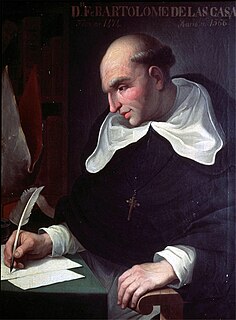 W
WBartolomé de las Casas was a 16th-century Spanish landowner, friar, priest, and bishop, famed as a historian and social reformer. He arrived in Hispaniola as a layman then became a Dominican friar and priest. He was appointed as the first resident Bishop of Chiapas, and the first officially appointed "Protector of the Indians". His extensive writings, the most famous being A Short Account of the Destruction of the Indies and Historia de Las Indias, chronicle the first decades of colonization of the West Indies. He described the atrocities committed by the colonizers against the indigenous peoples.
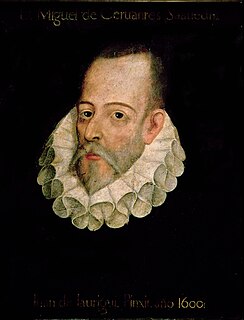 W
WMiguel de Cervantes Saavedra was a Spanish writer widely regarded as the greatest writer in the Spanish language, and one of the world's pre-eminent novelists. He is best known for his novel Don Quixote, a work often cited as both the first modern novel, and one of the pinnacles of literature.
 W
WFrancisco Delicado was a Spanish writer and editor of the Renaissance. Little is known about his life. He was born in Cordoba, Spain and, by uncertain reasons, he moved to Rome, where he became vicar and Italianized his surname to Delicado. After the sack of Rome, he went to Venice where he wrote his novel Portrait of Lozana: The Lusty Andalusian Woman, that continues on the lines of the novel in dialogue exemplified by Celestina. The book is a social and historical portrait of Rome and its dark side in the first years of the 16th century, and one of the first works of the picaresque novel. He was also a disciple of Antonio de Nebrija and editor of books such as Amadis de Gaula (1533), Celestina (1531–1534), Primaleon (1534) and some medical treatises like El modo de adoperare el legno de India and De consolatione infirmorum.
 W
WBernal Díaz del Castillo was a Spanish conquistador, who participated as a soldier in the conquest of Mexico under Hernán Cortés and late in his life wrote an account of the events. As an experienced soldier of fortune, he had already participated in expeditions to Tierra Firme, Cuba, and to Yucatán before joining Cortés. In his later years he was an encomendero and governor in Guatemala where he wrote his memoirs called The True History of the Conquest of New Spain. He began his account of the conquest almost thirty years after the events and later revised and expanded it in response to the biography published by Cortes's chaplain Francisco López de Gómara, which he considered to be largely inaccurate in that it did not give due recognition to the efforts and sacrifices of others in the Spanish expedition.
 W
WDiego Durán was a Dominican friar best known for his authorship of one of the earliest Western books on the history and culture of the Aztecs, The History of the Indies of New Spain, a book that was much criticised in his lifetime for helping the "heathen" maintain their culture.
 W
WJuan del Encina – was a composer, poet, and playwright, often called the founder, along with Gil Vicente, of Spanish drama. His birth name was Juan de Fermoselle. He spelled his name Enzina, but this is not a significant difference; it is two spellings of the same sound, in a time when "correct spelling" as we know it barely existed.
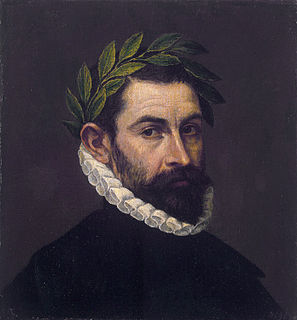 W
WAlonso de Ercilla y Zúñiga was a Spanish nobleman, soldier and epic poet, born in Madrid. While in Chile (1556–63) he fought against the Araucanians (Mapuche), and there he began the epic poem La Araucana, considered one of the greatest Spanish historical poems. This heroic work in 37 cantos is divided into three parts, published in 1569, 1578, and 1589. It tells of the courageous insurrection of the Araucanians and also relates the history of Chile and of contemporary Spain.
 W
WFrancisco López de Gómara was a Spanish historian who worked in Seville, particularly noted for his works in which he described the early 16th century expedition undertaken by Hernán Cortés in the Spanish conquest of the New World. Although Gómara himself did not accompany Cortés, and had in fact never been to the Americas, he had firsthand access to Cortés and others of the returning conquistadores as the sources of his account. However other contemporaries, among them most notably Bernal Díaz del Castillo, criticised his work as being full of inaccuracies, and one which unjustifiably sanitised the events and aggrandised Cortés' role. As such, the reliability of his works may be called into question; yet they remain a valuable and oft-cited record of these events.
 W
WAntonio de Herrera y Tordesillas was a chronicler, historian, and writer of the Spanish Golden Age, author of Historia general de los hechos de los castellanos en las Islas y Tierra Firme del mar Océano que llaman Indias Occidentales, better known in Spanish as Décadas and considered one of the best works written on the conquest of the Americas. It is worth noting that Herrera never visited or lived in any part of the Americas. Therefore his work was largely conjectural.
 W
WJuan de Jarava was a Spanish writer and physician. He is well known for his work in the field of botany and natural philosophy.
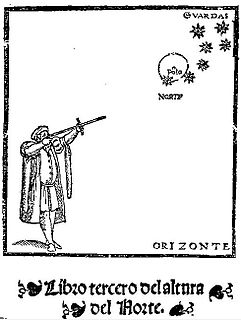 W
WPedro de Medina was a Spanish cartographer and author of navigational texts. His well-known Arte de navegar was the first work published in Spain dealing exclusively with navigational techniques.
 W
WBernardino de Mendoza was a Spanish military commander, a diplomat and a writer on military history and politics.
 W
WPedro Mejía, was a Spanish Renaissance writer, humanist and historian.
 W
WÁlvar Núñez Cabeza de Vaca was a Spanish explorer of the New World, and one of four survivors of the 1527 Narváez expedition. During eight years of traveling across what is now the US Southwest, he became a trader and faith healer to various Native American tribes before reconnecting with Spanish civilization in Mexico in 1536. After returning to Spain in 1537, he wrote an account, first published in 1542 as La relación y comentarios, which in later editions was retitled Naufragios y comentarios. Cabeza de Vaca is sometimes considered a proto-anthropologist for his detailed accounts of the many tribes of Native Americans that he encountered.
 W
WHernán Núñez de Toledo y Guzmán was a Spanish humanist, classicist, philologist, and paremiographer. He was called el Comendador Griego, el Pinciano or Fredenandus Nunius Pincianus. He earned his degree in 1490 from the Spanish College of San Clemente in Bologna. He returned to Spain in 1498 and served as a preceptor to the Mendoza family, in Granada. In this city, he studied classical languages as well as Hebrew and Arabic. Cardinal Gonzalo Ximénez de Cisneros hired him as censor of the cardinal's press at Alcalá de Henares. There, Nuñez worked on the Complutensian Polyglot Bible, specifically on the Septuagint. Nuñez was named professor of rhetoric at the Universidad Complutense, which had recently been founded. He then taught Greek from 1519. During the Castilian War of the Communities, Nuñez sided with the comuneros but avoided execution. He then taught at the University of Salamanca, occupying the post once filled by Antonio de Nebrija. At the age of 50, he retired from teaching to dedicate himself fully to research, although he seems to have still given classes on Hebrew at the University of Salamanca.
 W
WGonzalo Fernández de Oviedo y Valdés, commonly known as Oviedo, was a Spanish colonialist, historian and writer. Oviedo participated in the Spanish colonization of the West Indies, arriving in the first few years after Christopher Columbus, in 1492, became the first European to arrive at the islands. Oviedo's chronicle Historia general de las Indias, published in 1535 to expand on his 1526 summary La Natural hystoria de las Indias, forms one of the few primary sources about it. Portions of the original text were widely read in the 16th century in Spanish, English, Italian and French editions, and introduced Europeans to the hammock, the pineapple, and tobacco as well as creating influential representations of the colonized peoples of the region.
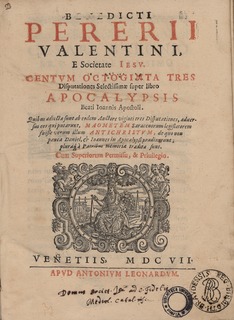 W
WBenedict Pereira was a Spanish Jesuit philosopher, theologian, and exegete.
 W
WGarci Rodríguez de Montalvo was a Castilian author who arranged the modern version of the chivalric romance Amadis of Gaul. Originally written in three books in the 14th century by an unknown author, Montalvo incorporated a fourth book in the original series, and followed it with a sequel, Las sergas de Esplandián. It is the sequel that Montalvo is most often noted for, not for the book itself, but because within the book he coined the word California.
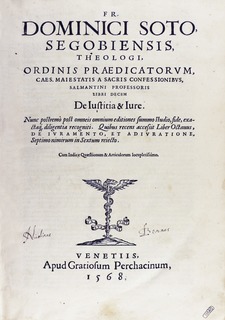 W
WDomingo de Soto was a Spanish Dominican priest and Scholastic theologian born in Segovia (Spain), and died in Salamanca (Spain), at the age of 66. He is best known as one of the founders of international law and of the Spanish Thomistic philosophical and theological movement known as the School of Salamanca. He is also known for his contributions to Mechanical Physics.
 W
WTeresa of Ávila, born Teresa Sánchez de Cepeda y Ahumada, also called Saint Teresa of Jesus, was a Spanish noblewoman who felt called to convent life in the Catholic Church. A Carmelite nun, prominent Spanish mystic, religious reformer, author, theologian of the contemplative life and of mental prayer, she earned the rare distinction of being declared a Doctor of the Church, but not until over four centuries after her death. Active during the Catholic Reformation, she reformed the Carmelite Orders of both women and men. The movement she initiated was later joined by the younger Spanish Carmelite friar and mystic John of the Cross. It led eventually to the establishment of the Discalced Carmelites. A formal papal decree adopting the split from the old order was issued in 1580.
 W
WGabriel Vasquez was a Spanish Jesuit theologian.
 W
WGarcilaso de la Vega, KOS was a Spanish soldier and poet. Although not the first or the only one to do so, he was the most influential poet to introduce Italian Renaissance verse forms, poetic techniques, and themes to Spain. He was well known in poetic circles during his lifetime, and his poetry has continued to be popular without interruption until the present. His poetry was published posthumously by Juan Boscán in 1543, and it has been the subject of several annotated editions, the first and most famous of which appeared in 1574.
 W
WLope Félix de Vega Carpio was a Spanish playwright, poet, novelist and marine. He was one of the key figures in the Spanish Golden Age of Baroque literature. His reputation in the world of Spanish literature is second only to that of Miguel de Cervantes, while the sheer volume of his literary output is unequalled, making him one of the most prolific authors in the history of literature. He was nicknamed "The Phoenix of Wits" and "Monster of Nature" by Cervantes because of his prolific nature.
 W
WAlonso de Villegas Selvago, also known as Selvago, which may also have been a second surname, of Genovese origin was a Spanish ecclesiastic and writer.
 W
WFrancisco de Vitoria was a Spanish Roman Catholic philosopher, theologian, and jurist of Renaissance Spain. He is the founder of the tradition in philosophy known as the School of Salamanca, noted especially for his contributions to the theory of just war and international law. He has in the past been described by some scholars as one of the "fathers of international law", along with Alberico Gentili and Hugo Grotius, though contemporary academics have suggested that such a description is anachronistic, since the concept of international law did not truly develop until much later. American jurist Arthur Nussbaum noted that Vitoria was "the first to set forth the notions of freedom of commerce and freedom of the seas."
 W
WFrancisco Xerez or Francisco de Jerez (1495–1565?) was a Spanish explorer-turned-historian, the personal secretary of conquistador Francisco Pizarro. He participated in the conquest of Peru during the first two unsuccessful expeditions led by Pizarro, Diego de Almagro and Hernando de Luque in 1524. Xerez did not stay and join The thirteen of the fame in the Isle of Gallo (1526).
 W
WJuan de Yciar or Iciar was a calligraphist and mathematician active in Zaragoza in the middle of 16th century.
 W
WJerónimo de Zurita y Castro or simply Jerónimo de Zurita was a Spanish historian of the sixteenth century who founded the modern tradition of historical scholarship in Spain.